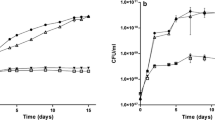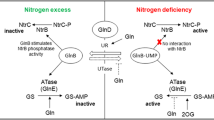Abstract
A Rhizobium etli Tn5mob-induced mutant (CFN035) exhibits an enhanced capacity to oxidize N,N,N′,N′, tetramethyl-p -phenylenediamine (TMPD), a presumptive indicator of elevated cytochrome c terminal oxidase activity. Sequencing of the mutated gene in CFN035 revealed that it codes for the amidophosphoribosyl transferase enzyme (PurF) that catalyzes the first step in the purine biosynthetic pathway. Two c-type cytochromes with molecular weights of 32 and 27 kDa were produced in strain CFN035, which also produced a novel CO-reactive cytochrome (absorbance trough at 553 nm), in contrast to strain CE3 which produced a single 32 kDa c-type protein and did not produce the 553 nm CO-reactive cytochrome. A wild-type R. etli strain that expresses the Bradyrhizobium japonicum fixNOQP genes, which code for the symbiotic cytochrome terminal oxidase cbb 3, produced similar absorbance spectra (a trough at 553 nm in CO-difference spectra) and two c -type proteins similar in size to those of strain CFN035, suggesting that CFN035 also produces the cbb 3 terminal oxidase. The expression of a R. etli fixN-lacZ gene fusion was measured in several R. etli mutants affected in different steps of the purine biosynthetic pathway. Our analysis showed that purF, purD, purQ, purL, purY, purK and purE mutants expressed three-fold higher levels of the fixNOQP operon than the wild-type strain. The derepressed expression of fixN was not observed in a purH mutant. The purH gene product catalyzes the conversion of 5-aminoimidazole-4-carboxamide ribonucleotide (AICAR) to 5-formaminoimidazole-4-carboxamide ribonucleotide (FAICAR) and inosine. Supplementation with AICA riboside lowered the levels of fixN expression in the purF mutants. These data are consistent with the possibility that AICAR, or a closely related metabolite, is a negative effector of the production of the symbiotic terminal oxidase cbb 3 in R. etli.
Similar content being viewed by others
Author information
Authors and Affiliations
Additional information
Received: 21 November 1996 / Accepted: 22 January 1997
Rights and permissions
About this article
Cite this article
Soberón, M., Lopez, O., Miranda, J. et al. Genetic evidence for 5-aminoimidazole-4-carboxamide ribonucleotide (AICAR) as a negative effector of cytochrome terminal oxidase cbb 3 production in Rhizobium etli . Mol Gen Genet 254, 665–673 (1997). https://doi.org/10.1007/s004380050464
Issue Date:
DOI: https://doi.org/10.1007/s004380050464




